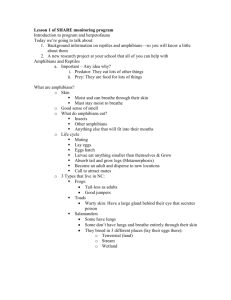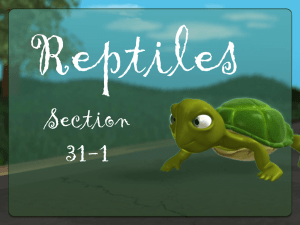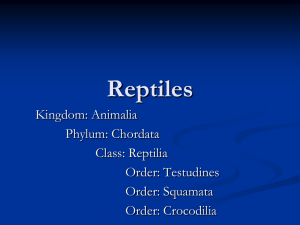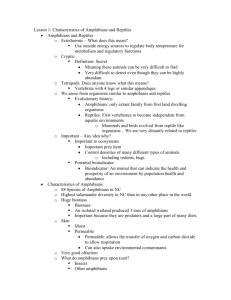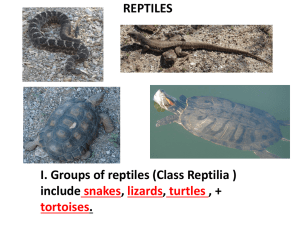Reptiles & Amphibians
advertisement
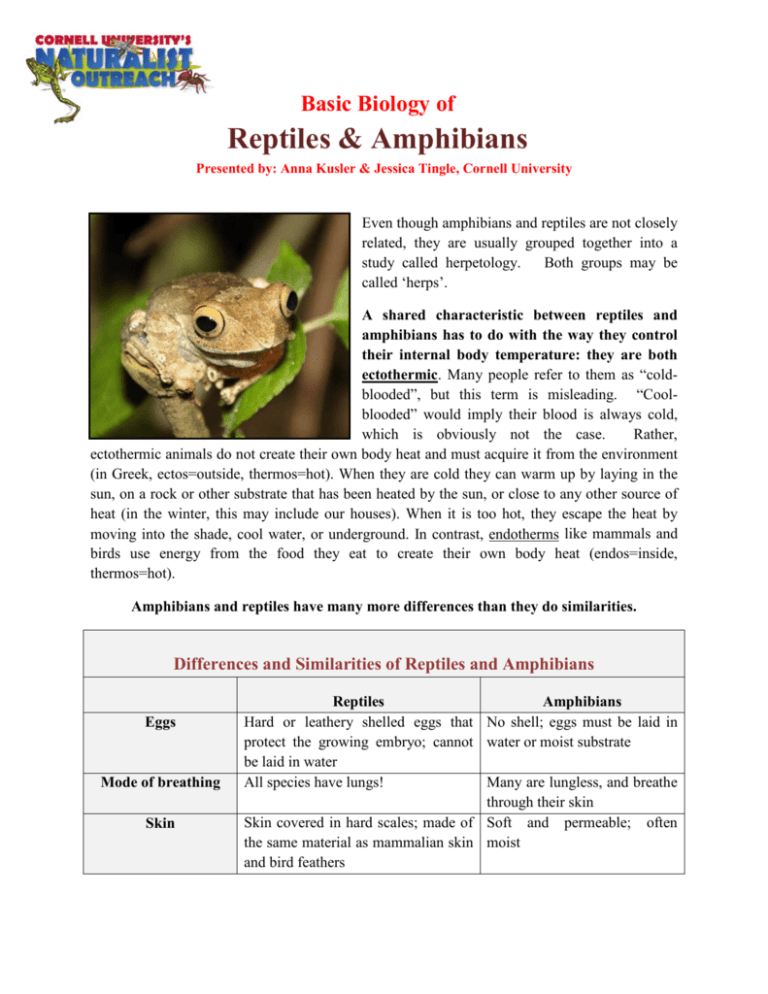
Basic Biology of Reptiles & Amphibians Presented by: Anna Kusler & Jessica Tingle, Cornell University Even though amphibians and reptiles are not closely related, they are usually grouped together into a study called herpetology. Both groups may be called ‘herps’. A shared characteristic between reptiles and amphibians has to do with the way they control their internal body temperature: they are both ectothermic. Many people refer to them as “coldblooded”, but this term is misleading. “Coolblooded” would imply their blood is always cold, which is obviously not the case. Rather, ectothermic animals do not create their own body heat and must acquire it from the environment (in Greek, ectos=outside, thermos=hot). When they are cold they can warm up by laying in the sun, on a rock or other substrate that has been heated by the sun, or close to any other source of heat (in the winter, this may include our houses). When it is too hot, they escape the heat by moving into the shade, cool water, or underground. In contrast, endotherms like mammals and birds use energy from the food they eat to create their own body heat (endos=inside, thermos=hot). Amphibians and reptiles have many more differences than they do similarities. Differences and Similarities of Reptiles and Amphibians Eggs Mode of breathing Skin Reptiles Amphibians Hard or leathery shelled eggs that No shell; eggs must be laid in protect the growing embryo; cannot water or moist substrate be laid in water All species have lungs! Many are lungless, and breathe through their skin Skin covered in hard scales; made of Soft and permeable; often the same material as mammalian skin moist and bird feathers Both groups are very diverse: Amphibians: 5,300 species Includes salamanders and newts, frogs and toads, and a little-known group called caecilians (that look somewhat like worms and live in the tropics) Reptiles: 8,000 species Includes turtles, crocodilians, tuatara, lizards, and snakes In comparison, there are only 4,800 species of mammals and 9,000 species of birds. Reptiles are broken down into four main classifications: Crocodilians, Turtles, Snakes, and Lizards. Crocodilians This extremely ancient lineage of reptiles includes crocodiles, alligators, and gharials. There are 23 remaining species, and are found in the tropics around the world. They have many interesting distinguishing characteristics: they are entirely carnivorous, and unlike humans which have 2 sets of teeth, crocodiles replace their teeth continuously throughout their lives. They have 4chambered hearts and temperature-dependant sex determination, meaning the gender of their offspring is determined by the temperature of the eggs during incubation. They are also very well known for having exceptional parental care; mothers defend their nests and offspring fiercely. Snakes Snakes are immensely diverse group. There are around 2,900 species, found on every continent except Antarctica. They range in size from a mere 4 inches to over 25 feet! Of the reptiles, snakes are most closely related to lizards. Together, they compose a group known as the squamates. In fact, snakes are actually a highly evolved kind of lizard! As such, there are certain kinds of lizards that more closely related to snakes than they are to other kinds of lizards. For example, an iguana is more closely related to a garter snake than it is to a gecko! Snakes have several characteristics that distinguish them from other reptiles. They are legless, have overlapping scales, and lack external ears and eyelids. A good way to tell the different between a snake and a legless lizard is the presence or absence of an external ear (which is typically just a small hole in the side of the head where you would imagine our ears to be). Snakes have internal fertilization and most lay eggs, though there are a few species that can give birth to live young. Snakes have unique flexible jaws that allow them to eat prey much larger than themselves; this will be discussed in greater depth later. Lizards Like snakes, Lizards are an extremely diverse group. There are around 3,800 species found on every continent except Antarctica. They range in size from a few inches to over 10 feet in length. Their diet varies greatly; some are entirely herbivorous, some entirely carnivorous, but many are omnivorous. Unlike snakes, turtles, and crocs, which have distinguishing characteristics, there are not true defining characteristics for lizards. Most have limbs, external ears, and eyelids, but there are exceptions for each of these traits. While many geckos and skinks have a special trait called “tail autotomy” (which will be described in greater detail later), most lizards cannot lose and re-grow their tail. One trait that is shared amongst most lizards is highly developed color vision. As such, color is often an important factor in lizard communication, displays, and food acquisition. Turtles Turtles are undoubtedly the most unique of the reptile lineages because of their characteristic shell. The shell itself is composed of bone which is then covered by keratinous scutes. The top of the shell is referred to as the carapace, and the bottom as the plastron. The area that connects the two is known as the bridge. Though most turtles are known to retract their head and necks into the safety of their shell, not all species are able to do so. The most ancient lineages of turtle are only able to tuck their head to the side of their shell, which does not provide as much protection. Turtles are generally known to be aquatic, but many species are adapted to a terrestrial lifestyle. One famous lineage of terrestrial turtles is known as the tortoises. Tortoises are almost entirely herbivorous, and can reach immense sizes and live for over 200 years. Lifestyle Adaptations Though reptiles are adapted to living in almost every habitat type on earth, they can generally be classified into three main lifestyles: life in the trees (arboreal), life on the ground, or life in the water (aquatic or semi-aquatic). Life on the ground Animals that live on the ground have one of two ways of life. They are either adapted to moving quickly throughout the landscape, or they are slow but able to protect themselves. Those lizard species that are quick generally have elongated arms, legs, and toes designed for propel them forward quickly. In the case of snakes, they typically have long, torpedo-like bodies that enable them to move through the environment with the least amount of drag. Those species that cannot move quickly must be able to defend themselves. These defense mechanisms will be discussed in greater depth later. Arboreal Animals that are arboreal are adapted for life in the trees, the canopy, and the surrounding foliage. They tend to be well adapted for climbing and hanging. Many have long, prehensile tails for counterbalancing their weight or aiding in movement. Their feet in particular are often highly adapted; some, like iguanas, have long, sharp nails for gripping the bark of trees. However other species like geckos and anoles have specialized toe pads which allow them to walk up walls by gripping tiny imperfections on an object’s surface. Chameleons have extremely specialized feet and toes that allow them to grasp branches and vines. Life in the water Aquatic and semi-aquatic reptiles have a number of adaptations that make them suited to life in the water. They must be able to move quickly through the water. The most common adaptations for this lifestyle include having a torpedo-like body, membranes over the eyes and ears, long, flattened tails that aid in locomotion, and webbing amongst the fingers and toes. Many, such as crocodilians and turtles, have their eyes and nostrils positioned on the top of their head, enabling them to breathe and see above water while most of their body remains submerged. While many species have become extremely well-adapted to life in the water, all aquatic reptiles must come onto land to lay their eggs. If eggs are fully submerged in the water, they will drown! Thus everything from sea turtles to crocodiles must come out of the water to lay their eggs on land. The babies must then hatch and make their way back to the water. Feeding Adaptations What do they eat? Most amphibians and reptiles are carnivores, meaning they eat other animals or insects. A few are herbivores, meaning they eat only plant material, and some are omnivores, meaning they will eat both. Since amphibians are generally small, they are more likely to eat invertebrate prey (insects, spiders, snails, etc.) The same is true for many lizard species, which are often omnivores that will eat both insects and plant matter such as fruit. Turtles and tortoises tend to eat more plant material than other groups of reptiles, but some of them are omnivores, and some are carnivores, like the leatherback sea turtle, whose diet consists entirely of jellyfish. Crocodilians and snakes are entirely carnivorous, and many of them can eat very large animals as prey. Amphibian and Reptile Feeding Diversity Carnivore: Snakes, Lizards, Turtles Herbivore: Lizards, Tortoises Omnivore: Lizards, Turtles How do they catch and subdue food? There are many ways for omnivores and carnivores to catch prey. Many aquatic amphibians have specialized ways to catch prey in the water. Many employ suction feeding, a system in which their mouthparts essentially become a vacuum to suck in water and any food that might be in it. Some turtles also have special adaptations for feeding in the water. Alligator snapping turtles have tongues that look like worms, which they use to lure unsuspecting fish into their mouths. Animals that feed on land must have very different strategies to capture prey than animals that feed in the water. Amphibians and reptiles in particular have evolved many ways to catch prey. Some salamanders, frogs, and chameleons have evolved tongue projection, an adaptation where they use special muscles to fling their tongues out of their mouths and use them to catch insects up to several inches away and sometimes even farther. Many predators use a sit-and-wait strategy, called ambush predation. Crocodilians lay beneath the water’s surface, camouflaged and completely still, until an animal comes to drink at the water’s edge. Many large species of snakes employ a similar tactic; using their camouflage, they remain hidden in one place for days or weeks for until their meal wanders by. Ambush predation is favorable because it requires very litter energy; better to sit and wait than waste energy actively looking for prey. Some of these snakes use venom to subdue their prey, while others use constriction. Smaller snakes (like common garter snakes) that eat smaller prey often use neither method; they simply eat swallow their prey alive. How do snakes swallow such big prey? Snakes are able to swallow prey that is often much bigger than they are. This ability comes from special adaptations in their jaw muscles. Snakes, like people, have an upper jaw and the lower jaw. We can feel the point where the upper jaw and lower jaw are connected by touching our cheeks near our ears, and then opening and closing our mouths. In humans, as in most other animals, the upper and lower jaws are permanently attached. However, snakes have the ability to disconnect their upper and lower jaws in order to open their mouths wider. They have another modified bone that helps them swallow. Mammals have a small dimple in the center of their chin; this is the spot where the two halves of our lower jaw are fused together. In snakes, the halves of the jaw are separate rather than fused. This allows exceptional jaw flexibility and movement. Snakes can inch one side of their lower jaw over the prey, then inch up the other side, in a sort of “walking motion” until the prey is completely swallowed. Defense Physical adaptations Some reptiles have physical adaptations that help protect them from predators. An obvious example is the turtle shell, which is usually hard enough to prevent large predators from biting through. Many lizards, such as bearded dragons, have specialized scales that look like spikes. When these animals inflate their bodies and stiffen their skin (much like the defense of the pufferfish), the spikes become erect and prevent predators from swallowing them. Some lizards, such as geckos and skinks, have tail autotomy. In species with this trait, there are areas of weakness between the vertebrae in the tail. When the lizard is frightened or the tail is seized, the tail breaks off at this weakness point. Sphincter muscles contract to reduce bleeding. The remaining tail continues to wiggle for some time, attracting the attention the predator. While the predator’s attention is diverted, the lizard can run away safely! This tail can then re-grow, although the new appendage will be composed of cartilage instead of bone. Behavioral defense Animals can also use behavior to help defend themselves. Many reptiles and amphibians spend much of their time hiding under rocks, in holes, or underwater where it is difficult for predators to find them. Some try to make themselves look bigger to intimidate anything that threatens them. Others have more unusual behaviors. The hognose snake rolls onto its back, lolls its tongue out, and emits a rotting smell so that predators think it is dead or dying. They do not want to eat something sick or dead and risk getting sick themselves, so they leave the hognose snake alone. Other species may mimic the posture of venomous snakes, or only come out at night when it is more difficult to be detected. Chemical defense Many amphibians and some reptiles use chemicals to prevent other animals from eating them. Amphibians frequently have poison in their skin so that any animal that eats them will get sick or possibly die. Toads and newts commonly employ this tactic. The lumps on their bumpy skin are often glands that produce poison. Usually the excretions from these glands won’t hurt us if we just touch them; however they can be irritate or burn if they get in your eyes, nose, or mouth. Venomous snakes can use their venom for defense, but prefer to save this valuable resource for catching dinner. That is why rattlesnakes have a rattle; they prefer to give a warning to intruders, rather than be forced to use their venom in self defense. One notable exception is the spitting cobra: its venom is primarily for defense, not subduing prey. It has specialized fangs to shoot venom into the eyes of an attacker, blinding them and allowing the snake to escape. Defensive coloration There are several ways that an animal can use coloration for defense. One strategy is warning coloration, known by scientists as aposematic coloration or aposematism. Amphibians that have poison in their skin want to advertise this, and do so by having brightly colored skin. The red eft (the terrestrial juvenile phase of the redspotted newt) found in the eastern United States is red for just that reason. Coral snakes are also brightly colored with their red, yellow, and black stripes to advertise their dangerous venom and warn other animals to stay away. Some harmless animals take advantage of the dangerous animals’ warning coloration. In a strategy called mimicry, harmless animals have bright colors to make themselves look like dangerous animals. The red salamander and the scarlet kingsnake are completely harmless, but since they look like the poisonous red eft and the venomous coral snake, other animals often avoid them. A third type of defensive coloration is camouflage. In this strategy, the animal tries to blend in so that predators can’t find it. The gray treefrog is the same shade of mottled gray as the bark that is usually rests on, and the bullfrog and green frog are the same color green as the algae in the ponds where they live. Camouflage allows animals to remain hidden in plain sight. Fun activities Most kids love to draw, so this activity will simultaneously test their level of understanding and allow them to use their creativity! Pick an environment, lifestyle, or location and write it on the board. For example, you could use “the desert of Africa”, “your backyard”, or “the canopy of the Amazon jungle”. Using what they’ve learned, have the students design and draw a picture of a made-up reptile or amphibian that would be adapted to that habitat or lifestyle. If you have time, have them present it to the class (or to each other), describing what its particular adaptations are and how it uses them in its lifestyle. Resources Book Resources: Conant, Roger, and Joseph T. Collins. Reptiles and Amphibians of Eastern/Central North America. New York: Houghton Mifflin, 1998. Website Resources: The Cornell Herpetological Society: rso.cornell.edu/cuherps New York State Department of Environmental Conservation - Amphibians and Reptiles: http://www.dec.ny.gov/animals/277.html For more information on local species Smithsonian National Zoological Park – Conservation: http://nationalzoo.si.edu/SCBI/SpeciesSurvival/AmphibianConservation/default.cfm For more information on conservation For Viewing: The most exceptional documentary series on reptiles and amphibians is the BBC series “Life in Cold Blood”, narrated by David Attenborough.
